Photographer
- John E. Allen
- Richard Buchta
- Jean Carlile Buxton
- E. E. Evans-Pritchard Collection:
- Godfrey Lienhardt
- Charles Kingsley Meek
- G. N. Morhig postcard series:
- Percy Horace Gordon Powell-Cotton
- Charles Gabriel Seligman slide collection
- Wilfred Patrick Thesiger
E. E. Evans-Pritchard Collection: Southern Sudan
The photograph collection donated by Evans-Pritchard to the Pitt Rivers Museum in 1966 was arranged into a number of discrete sections, according to cultural group (apart from the Dar Fung material), and also contained singificant numbers of items relating to fieldwork in Kenya, Ethiopia and Egypt.
Of the 4940 negatives and prints relating to Southern Sudan, some 43 were not taken by Evans-Pritchard himself, but by a number of other individuals who gave him prints. These include colonial administrators such as Frank D. Corfield, Edward Smyth Crispin, Charles W. Gwynn, Talib Ismail and Archibald Norman Tucker, as well as an American missionary, Blanche Cora Soule.
Storage and Conservation
The Evans-Pritchard Collection prints were stored in mylar sleeves with acid-free card backing for support and their conservation noted in the mid 1980s. As part of the 2003-2005 project these storage arrangements were individually assessed, and any changes in the conservation of the photographs noted. This information is available under the heading Conservation in the catalogue record for each object. Note that only conservation concerns are recorded.
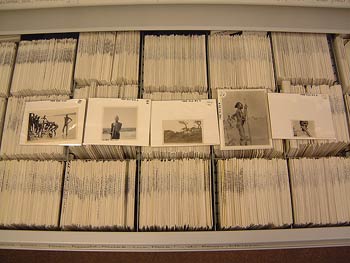 Prints were stored in plastic sleeves with acid-free card backing.
Prints were stored in plastic sleeves with acid-free card backing.
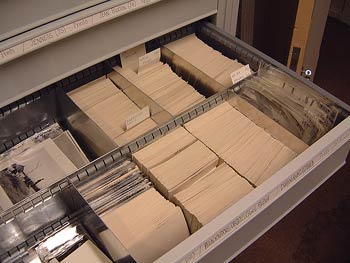 As part of the 2003-2005 project the negatives have all been re-sleeved in individual acid-free paper envelopes.
As part of the 2003-2005 project the negatives have all been re-sleeved in individual acid-free paper envelopes.
Registry History
The Evans-Pritchard Collection was stored according to conservation practices in the mid 1980s. Until then they were probably kept in the boxes, packages and albums in which they were donated, as recorded in the Museum’s accession register of the time.
Nuer 1930, 1931, 1935, 1936
The Museum’s accession book records that the Nuer photographs were donated in two discrete sections. The first comprises a group of 1600 photographs and negatives within sixteen small 100–sleeve albums, each containing 50 negatives with their respective 50 prints (see photo below, of some that remain in the department). These albums seem to relate to his two shorter, but photographically prolific, trips of 1935 and 1936.
“1966.27 [1 - 24] G[ift] PROFESSOR E. E. EVANS-PRITCHARD; INST. OF SOCIAL ANTHROPOLOGY, 51 BANBURY RD. OXFORD 1966.27.1-16 S. SUDAN. NUER TRIBE. Sixteen negative albums containing negatives and prints of photographs taken by donor during fieldwork. All listed in albums.”
Within each album of this type was a list of its contents, filled in by Evans-Pritchard himself, mostly with the briefest of descriptions:
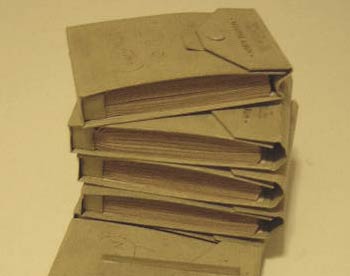 Small 100–sleeve albums, each containing 50 negatives with their respective 50 prints.
Small 100–sleeve albums, each containing 50 negatives with their respective 50 prints.
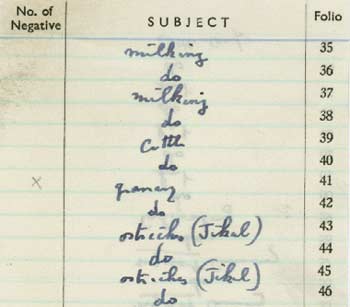 Within each album of this type was a list of its contents.
Within each album of this type was a list of its contents.
Both the album and the sleeve number were recorded on the white border of the prints stored within these albums, with the album number written in Roman numerals, and the sleeve number in digits.
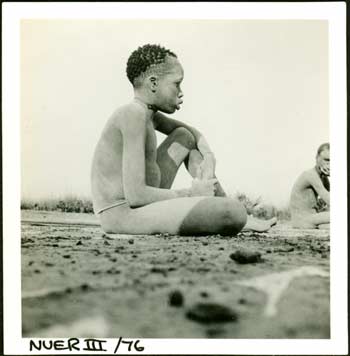 The album number written in Roman numerals and the sleeve number in digits on 1998.355.137.2.
The album number written in Roman numerals and the sleeve number in digits on 1998.355.137.2.
The second section of Nuer photographs was composed of a box of negatives and prints, believed (according to the accession book) to number some 213 since an accompanying handlist (see image below) stopped at this number. There were in fact nearly 370 prints and negatives in this section, with the last 150 or so unlisted by Evans-Pritchard. This box of photographs seems to relate to his longer, but less photographically active, fieldwork of 1930-1931.
“1966.27 [1 - 24] G[ift] PROFESSOR E. E. EVANS-PRITCHARD; INST. OF SOCIAL ANTHROPOLOGY, 51 BANBURY RD. OXFORD 1966.27.17 S. SUDAN. NUER TRIBE. Box of negatives each in separate envelope, labelled. (some missing). Nos. 1 - 213. (prints in box 1966.27.18).& Box of prints each in separate envelope. Nos. 1 - 213. (negatives in 1966.27.17.)”
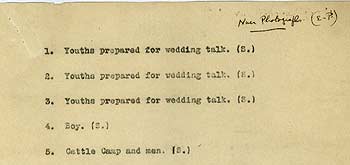
Dar Fung & Bahr-el-Ghazal 1926-1927
Two different typewritten handlists were donated with the 1926/1927 Ingessana photos taken in the Tabi Hills of Blue Nile Province, Evans-Pritchard’s first short Sudanese fieldwork, en route to Zandeland. The first list is the original catalogue made by Evans-Pritchard in early 1928 between his first and second fieldwork trips. Its numbers run on to include photographs of Moro, Bongo and Rumbek Jur photographs, taken in Bahr-el-Ghazal in 1927, also during his first trip:
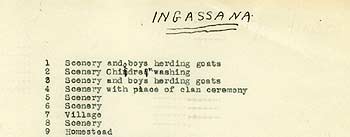
 Typewritten handlists.
Typewritten handlists.
“1966.27 [1 - 24] G[ift] PROFESSOR E. E. EVANS-PRITCHARD; INST. OF SOCIAL ANTHROPOLOGY, 51 BANBURY RD. OXFORD [1966.27.19 - S. SUDAN, DARFUNG. VARIOUS TRIBES. Box of negatives in envelopes, 1 - 242] 1966.27.20 Box of prints of these negatives [refers to object 1966.27.19] 1 - 242, in envelopes.”
An accompanying letter to C. G. Seligman survives, and outlines how Evans-Pritchard catalogued and left his fieldwork negatives on leaving for fieldwork in 1928 in Seligman’s office at LSE, evidently for the latter’s free use in preparing his ethnographic survey, Pagan Tribes of the Nilotic Sudan (Routledge 1932). The Ingessana and Moro prints were to be kept, he asks, at the Seligman’s home at Toot Baldon in Oxfordshire, whilst his Zande prints were kept with him in the Sudan.The catalogue list however was evidently not finished before he left, and he posted it in April from Marseilles on board the S.S. Amarapoora, en route to his next phase of Zande fieldwork.
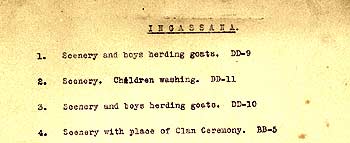 Darfung list.
Darfung list.
Sometime later Evans-Pritchard evidently made an entirely new list for his Ingessana photographs, and although most of the descriptions remain the same, he this time includes details such as film numbers:
Zande
A handlist and carbon copy donated with the several boxes of Zande photographs details important information such as names and film numbers, much of which is invaluable to research:
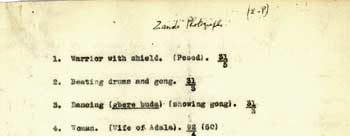 Zande list.
Zande list.
“1966.27 [1 - 24] G[ift] PROFESSOR E. E. EVANS-PRITCHARD; INST. OF SOCIAL ANTHROPOLOGY, 51 BANBURY RD. OXFORD [p. 99] 1966.27.21 S. SUDAN, AZANDE TRIBE. Box of negatives in envelopes. Nos. 1 – 400. Box of negatives in envelopes. Nos. 401 - 699 and 706 - 712. Box of prints in envelopes, nos. 1 – 400. Box of prints in envelopes, nos. 401 - 699,
& 706 - 747 & some odd ones.”
More research on the Zande series will hopefully flesh out some of the fieldwork contexts in which they were taken. For instance it is far from clear at present to which fieldwork phases the photographs belong, and therefore the Museum’s catalogue at present remains frustratingly within the 1926-1930 range. Some tantalising clues are available in the literature. In the year of his death, 1973, he published an article entitled ‘Some Recollections on Fieldwork in the Twenties’ (Anthropological Quarterly, 46, pp.235-242) in which he notes that “An Arab merchant’s lorry, with, as I afterwards realized, faulty brakes went over the ferry into the Wau river at its period of flood and I lost my camera and collection of Zande negatives, and almost my life too.”

